Which SUV Features Do You Need to Ensure a Comfortable Road Trip?

Year-round, many Americans are putting wheels to the pavement to explore new places in their vehicles. In fact, according to a recent survey conducted by Mazda, 93% of respondents said they enjoyed taking road trips. Whether you're going on your next road trip to take in scenic views, have an adventure, just wing it on the go, or all the above, you’ll want a vehicle that’s built with your safety, comfort, and driving needs in mind.
Of our survey respondents, more than half (51%) said they would prefer to road trip in an SUV, with 31% opting for a two-row configuration while the remaining 20% preferred a three-row design. Mazda SUVs — particularly the three-row CX-90 and two-row CX-70 — are known for giving families the space they need to store all their equipment and luggage while still providing enough room for a comfortable trip.
But what other features and amenities — be they baseline, safety, or technology-related — did our survey respondents say they found essential to an enjoyable road trip, be that in an SUV or other type of car? In other words, what do North Americans believe makes the perfect vehicle for the ultimate road trip?
Must-have baseline driving features for a road trip
With more than 78% of survey respondents saying they’d be willing to spend 6 hours or more driving to their destination, there’s a chance that if you’re going on a road trip, you’re going to be spending a decent amount of time in your car. Given the long hours spent behind the wheel or in the rear seat, vehicle “basics” can make a big difference to your overall experience.
Here’s what baseline vehicle features Americans said they found the most (and least) essential for their adventures on the road.
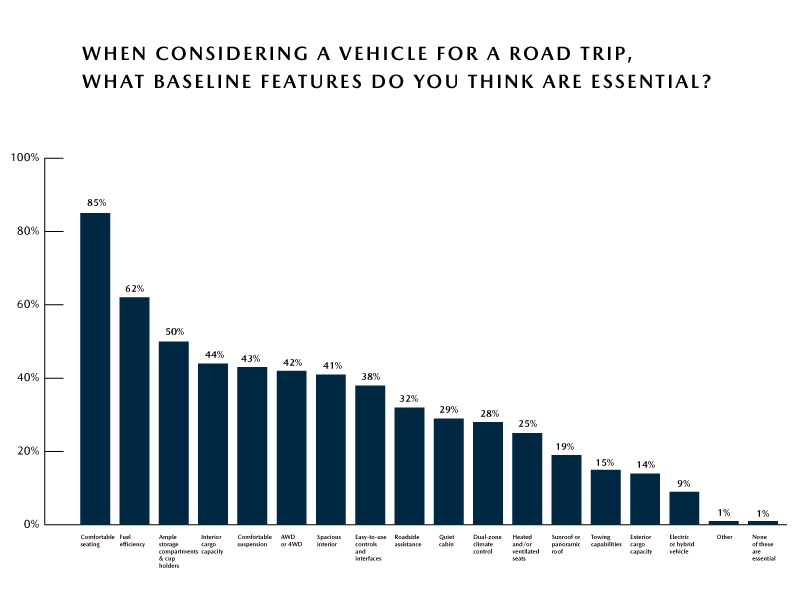
1. Comfortable, supportive seats (85%)
Comfortable, supportive seats are a must for any road tripper. If you’re part of the 38% of respondents who said they were willing to spend 11+ hours in the car driving to your destination, investing in a vehicle with good seats that offer lateral and posture support can help minimize the pain and fatigue associated with sitting in the same place for hours on end.
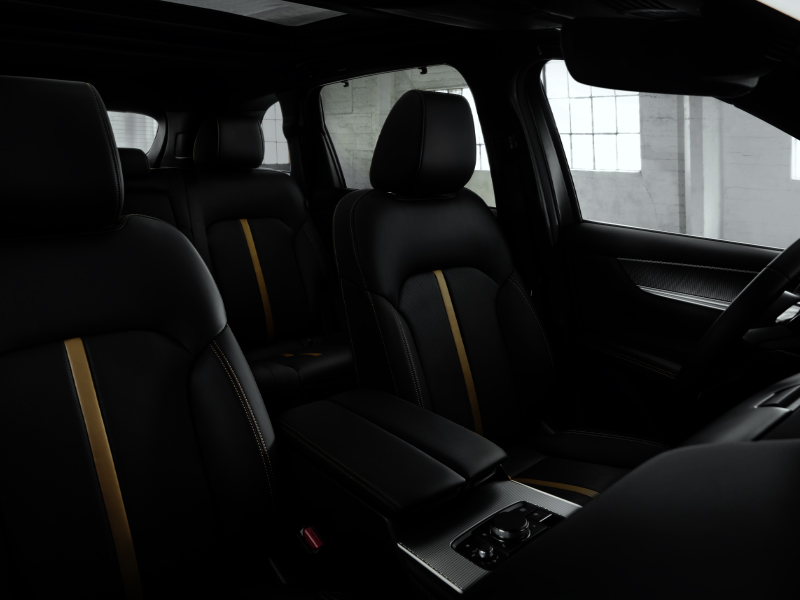
2. Fuel efficiency (62%)
Many people opt for a road trip instead of booking a flight to save money and other travel-related hassles. But, if you’re driving a fuel-inefficient vehicle, the cost of refueling could quickly eclipse the cost of a plane ticket on long drives — making your thrifty decision to drive instead of fly less meaningful. The cost savings of a fuel-efficient vehicle, however, can then be allocated elsewhere, such as accommodations, meals, or entrance fees.
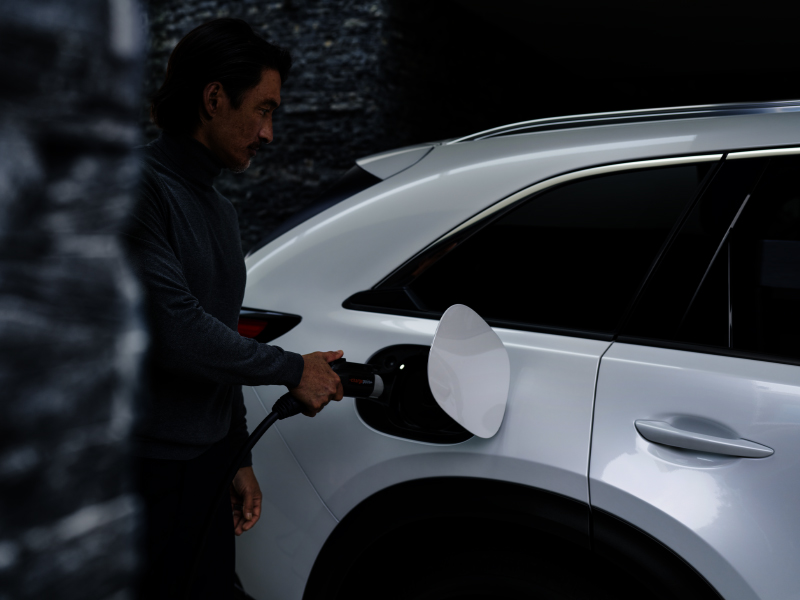
Optional charging equipment shown
An electric vehicle, or plug-in hybrid electric vehicle (PHEV), can also help you save money at the pump as more electric-vehicle charging stations crop up around the country. Here are some tips:
● If you’re planning on taking your EV on a road trip, plan for how long it takes to charge an EV. This number will depend on the charging level your vehicle has, available chargers, and whether you have a battery electric vehicle (BEV) or a PHEV.
● While the range of EVs has improved significantly since they first became available, it’s still important to be aware of your car’s range limits — which can help reduce any range anxiety you might have with taking your EV on a road trip.
● In addition to charging your EV, keep in mind that the temperature’s effect on EV batteries can impact your vehicle’s performance on road trips.
3. Ample storage (50%)
Depending on where you’re traveling to and how many people you’re taking, you’re going to need plenty of space to accommodate everyone and their belongings. The best road trip vehicles provide lots of room for storing cargo, both inside and outside of the car.
Interior cargo capacity (44%)
An SUV is a preferred choice for road trips as these vehicles typically provide plenty of interior space for transporting luggage.
Exterior cargo capacity (14%)
Separating gear that otherwise cramps passengers makes for easier loading and more comfortable travel.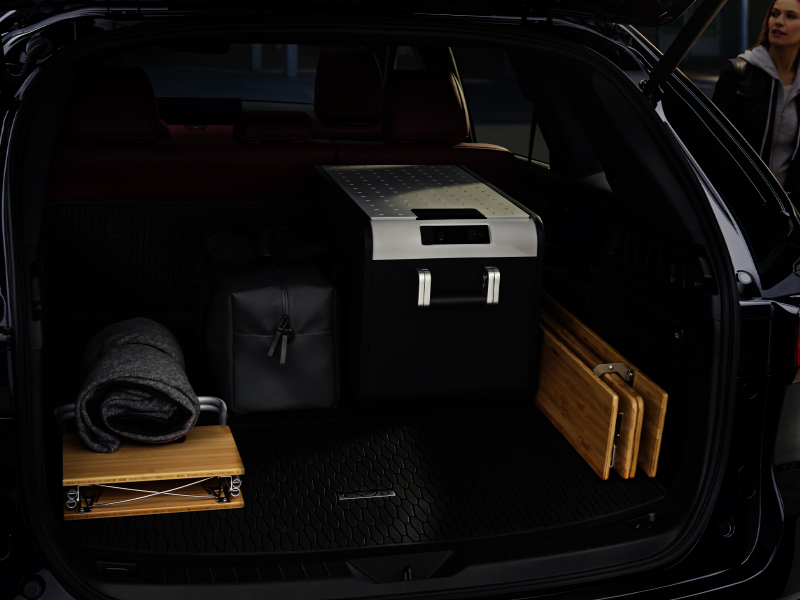
Please remember to properly secure all cargo.
The Mazda CX-70 and the CX-70 PHEV both provide ample interior cargo space as well as exterior cargo capacity with the simple addition of available accessories like rooftop crossbars and cargo boxes or equipping the vehicle for towing.
4. AWD or 4WD (42%)
All-wheel drive and four-wheel drive both help to ensure that your vehicle can better handle certain terrain or weather conditions. An AWD SUV in particular is a great option for travelers who want to take their adventures off-road because all-wheel drive automatically adapts to changing road conditions and provides better traction and control in inclement conditions like snow or mud.
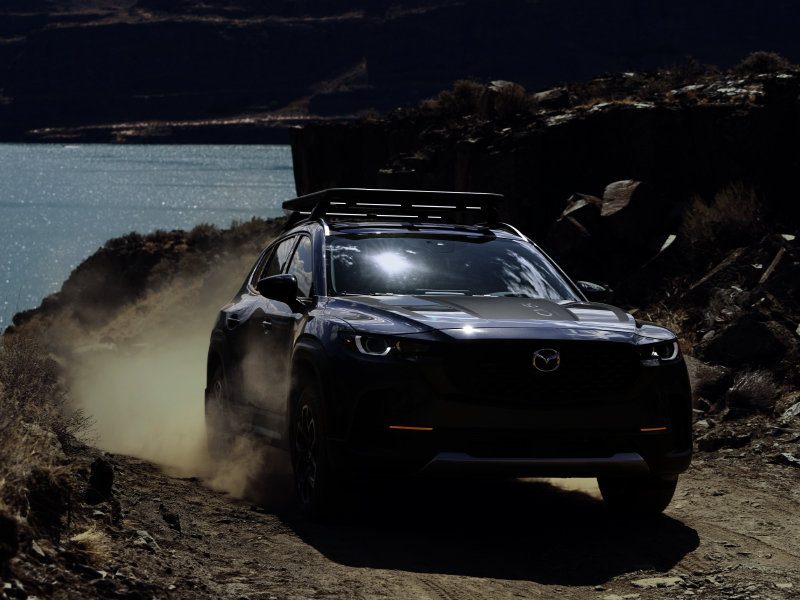
The Mazda CX-50 is an off-road-ready crossover SUV with standard i-Activ AWD®. An additional Off-road driving mode, part of Mazda Intelligent Drive Select (Mi-Drive), improves the CX-50 Off-road capabilities, while available Towing mode contributes to a towing capacity of up to 3,500 pounds.
5. Spacious interior (41%)
Another feature Americans find essential in a road trip vehicle is a spacious interior. With 37% of survey respondents planning to take children along with them on their next road trip, wanting a roomy rear seat makes sense.
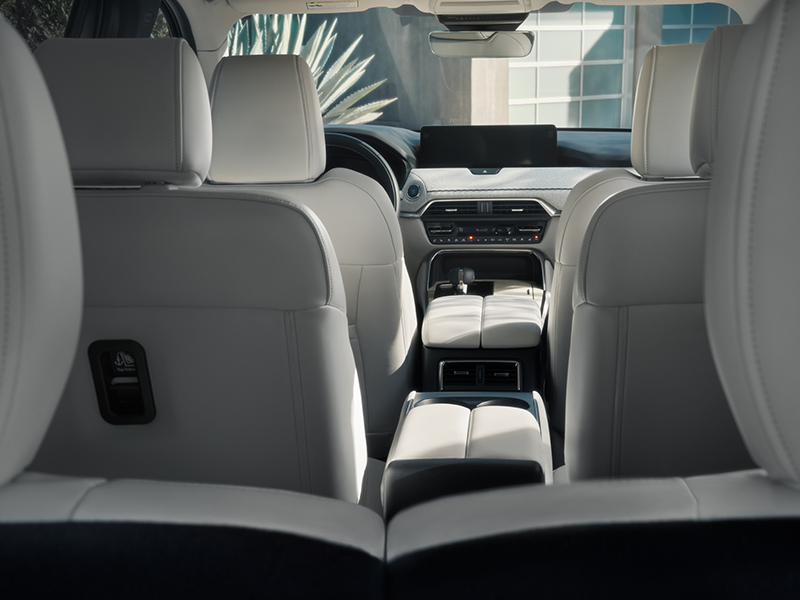
The Mazda CX-90 and the CX-90 PHEV each offers three rows of seating designed with passenger comfort in mind. The CX-90 provides versatile seating choices depending on the specific CX-90 trim. Equipping a CX-90 with a second-row bench seat or optional dual captain's chairs and a 2- or 3-person third-row bench seat creates capacity for 6, 7 or 8 passengers.
6. Easy-to-use controls (38%)
Easy-to-use controls are a feature that can help you remain focused on the road in front of you, so it makes sense why people prefer vehicles with simple driver assistance technologies that enhance the safety, convenience, and enjoyment of their travels. Remember, you should always try to modify your vehicle’s settings — like music, navigation system destinations and routes, air conditioning, and mirrors — before driving to minimize on-road distractions.
The Mazda intelligent Drive Select (Mi-Drive) system makes it easy for drivers to switch between drive modes to meet any driving need at the moment, like off-roading or towing (when properly equipped).
7. Roadside assistance (32%)
In the unfortunate event of a breakdown mid-trip, having reliable roadside assistance coverage can be a lifesaver. Mazda Emergency Roadside Assistance, for example, is available 24/7 for all new vehicles and lasts the entire duration of the New Vehicle Limited and Powertrain warranties.
8. Quiet cabin (29%)
A quiet cabin is also seen as essential for road trips as it creates a serene and comfortable environment, reducing driver fatigue and enhancing overall relaxation. It allows passengers to enjoy conversations, music, or simply peaceful moments staring out the window without other distractions. A vehicle with a quiet cabin also contributes to better focus and attentiveness, promoting safer driving during long journeys.
9. Dual-zone climate control (28%)
We’ve probably all experienced a situation where we’ve been riding in the passenger seat and were either burning up or freezing cold while the driver hummed along to the radio, unaffected by the temperature. While this is great for the driver, one temperature for the entire vehicle can quickly become uncomfortable for passengers, especially when heading north or south. With an available dual-zone climate control system, the driver and front passenger can individually set their preferred temperature, creating a personalized climate experience within the cabin. The Mazda CX-90 employs three-zone climate control, giving passengers in the rear added flexibility to set the temperature to their ideal comfort level.
10. Heated and/or ventilated seats (25%)
We’ve already talked about how supportive seats are seen as a must-have feature for road trips, but heated and ventilated seats are increasingly seen as comfort must-haves. Heated seats provide warmth and comfort during chilly days, while ventilated seats help keep occupants (typically just front-seat occupants) cool and comfortable in hot weather.
Must-have safety features for a road trip
Now let’s look at the safety features that Americans found to be the most necessary for a road trip.
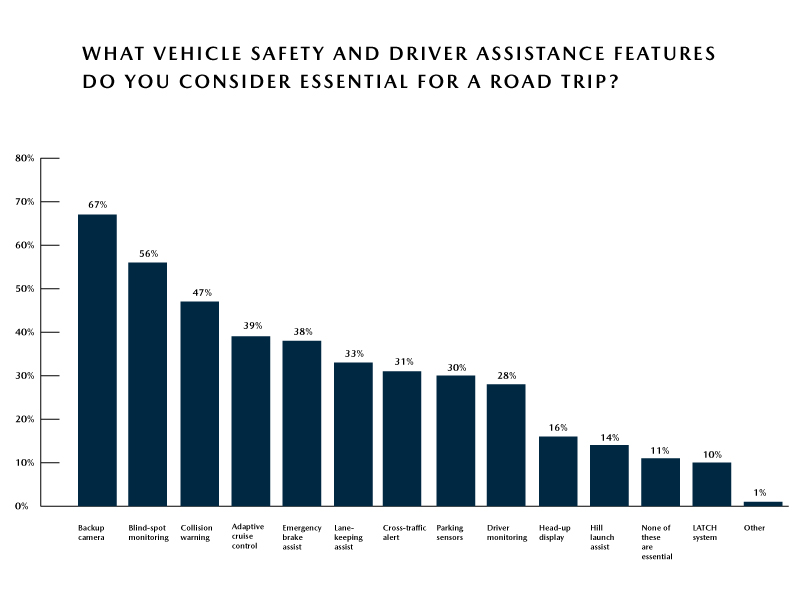
1. Backup camera (67%)
2. Blind spot monitoring (56%)
3. Collision warning (47%)
4. Adaptive cruise control (39%)
5. Emergency brake assist (38%)
Brake assist is especially beneficial for drivers who find themselves in urgent situations when they need to brake quickly. If the driver can’t exert enough pressure on the brake pedal due to panic or distractions, emergency brake assist is a supplement to conventional braking mechanisms. Upon detecting abrupt or forceful braking maneuvers by the driver, the system instantly amplifies brake pressure to minimize stopping distance and help mitigate potential collisions. This is a great safety feature when driving long distances or in unfamiliar locations, as it maximizes braking response.
6. Lane-keeping assist (33%)
7. Cross-traffic alert (31%)
8. Parking sensors (30%)
9. Driver and road monitoring (28%)
10. Head-up display (HUD) (16%)
Head-up display technology projects driving data like speed and navigation directions onto the windshield or a pop-up panel atop the dashboard where it is closer to the driver's line of sight. This aims to minimize the driver's need to look away from the road.
Must-have technology features for a road trip
The best travel SUV also needs to have some tech features to contribute to the overall road trip experience. Survey respondents had different priorities when it came to must-have technology features for their best road trip vehicles. In this section, we’ll explore these features more in depth.
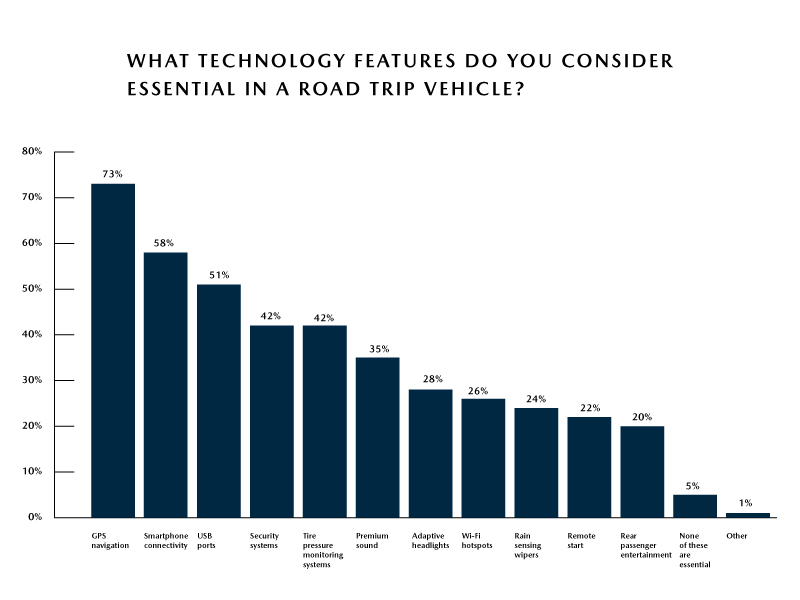
1. Navigation (73%)
Very few people want to pull out a cumbersome paper map these days, let alone fight over directions with whoever is navigating. An in-car navigation system can eliminate this headache, and when coupled with a head-up display system like we mentioned above, helps drivers stay on the route while also staying focused on the road. Navigation systems are also an important way to stay on track while traveling. If there are road closures or delays, most navigation systems will automatically reroute you away from traffic to help you reach your destination faster.
2. Smartphone connectivity (58%)
Some automakers now have their own navigation apps that connect with smartphones to provide drivers with real-time directions, on-demand music and podcasts, and cell phone connectivity for emergency calls or messages. These apps provide drivers with access to these functionalities while helping to maintain safety.
3. USB ports (51%)
When you’re traveling long distances, you and your passengers will likely need USB ports to charge phones and any entertainment devices being used during the trip. Having multiple USB ports in your car is useful for several reasons. All of us at one point or another have likely experienced the stress of a navigation app draining your phone battery before reaching a destination. Circling back to the 37% of survey respondents who said they were planning to bring children on their road trip, if they’re playing on portable devices or watching movies, having multiple USB ports can help keep their devices alive, which can feel essential when non-electric entertainment has run its course, and everyone is feeling antsy.
4. Security systems (42%)
Visiting new places can come with increased levels of security risk to your belongings — including your vehicle. Many vehicles already come equipped with standard alarm systems that helps alert people in the event of potential theft. Other systems can emit a “silent” alert that instead notifies the vehicle owner or a security company of the suspicious activity. While there are varying levels of security technology you can add to your vehicle, having some level of protection is great for road trippers, because the last thing you want on your road trip is for your car to get stolen.
5. Tire Pressure Monitoring Systems (TPMS) (42%)
Newer vehicles have tire pressure monitoring systems (TPMS) that help drivers monitor the inflation levels of their tires. If your vehicle doesn’t have this feature, you can buy a TPMS and have it installed. These monitors are great for ensuring your tires remain in good condition, as properly inflated tires are safer, last longer, and can even improve your fuel economy compared to under or over-inflated tires.
6. Premium sound (35%)
What is a great road trip without a great soundtrack? With a premium sound system, you don’t have to wonder. While it’s a little lower on the list of tech essentials, a premium sound system can contribute immensely to the overall enjoyment of your road trip.
7. Wi-Fi hotspots (26%)
Maybe you’re a travel blogger looking to document your road trip, or one of your passengers is working remotely during part of your trip. An in-car Wi-Fi hotspot can help maintain an internet connection, enabling you and your passengers to work or access the internet from nearly anywhere. In addition, vehicles with Wi-Fi connectivity can access real-time traffic updates, navigation routes, satellite music, and more.
8. Rain-sensing wipers (24%)
Another tech feature that can enhance the safety of your vehicle is rain-sensing windshield wipers. Using an infrared sensor, rain-sensing wipers detect precipitation on your windshield and send a signal to the system to initiate or increase the speed or frequency of your windshield wipers. Wipers will stop automatically when the precipitation stops. This can be especially useful for drivers to maintain safety while dealing with heavy rain.
9. Remote start (22%)
Remote engine start technology allows you to start the vehicle without being physically present inside of it to turn the key in the ignition or push the button. This is a convenience that can allow you to heat up or cool down the cabin before you and your passengers get in if you know the weather is extreme one way or the other. Manufacturers also include remote door locking and unlocking and remote hazard lights as part of their remote offerings to enhance convenience and safety for the user.
10. Rear passenger entertainment systems (20%)
This system can include features like screens for movies or games, audio options, and connectivity for devices, providing a distraction-free environment for the driver and giving passengers a break from counting, say, the number of blue 18-wheelers on the road.
The best Mazda SUVs for road trips
Mazda offers a range of SUVs perfect for any road trip, each with distinct features catering to different traveler needs.
● The Mazda CX-30 is a perfect compact SUV that comes with standard AWD.
● The Mazda CX-5 offers an elevated driving experience, with its sleek design and elegant details.
● The Mazda CX-50 stands out as an off-road-ready CUV, equipped with standard i-ACTIV All-Wheel Drive® and rugged capabilities to tackle various terrains, making it ideal for adventurous road trips.
● The Mazda CX-70 boasts excellent performance and exceptional storage capacity, providing ample room for luggage, gear, and essentials, helping you stay comfortable and organized on your journey without having to compromise on cargo space.
● For those seeking a spacious and versatile option, the Mazda CX-90 is a top choice with its three rows of seating for up to 8 passengers, accommodating large groups or families comfortably during extended road trips.
Find your next road-trip-ready vehicle with Mazda
Ready to explore the Mazda road-trip-ready SUV lineup firsthand? Schedule a test drive today to immerse yourself in the performance, comfort, and safety features that set Mazda SUVs apart. Locate a dealer near you and embark on your next adventure with confidence and style. Your road trip journey begins here with Mazda.
Methodology and Definitions
The findings presented in this article are the result of a February 2024 study of 2,523 U.S. adults. (Confidence Level: 95%, Margin of Error: 2%)
Age Cohorts (based on Pew Research Definitions)
● Baby Boomers: 1946-64
● Gen X: 1965-80
● Millennials: 1981-96
● Gen Z: 1997-2012
Regions (based on U.S. Census Regions)
● West: Arizona, California, Colorado, Idaho, Montana, New Mexico, Nevada, Oregon, Utah, Washington, Wyoming
● Midwest: Iowa, Illinois, Indiana, Kansas, Michigan, Minnesota, Missouri, North Dakota, Nebraska, Ohio, South Dakota, Wisconsin
● South: Alabama, Arkansas, Delaware, Florida, Georgia, Kentucky, Louisiana, Maryland, Mississippi, North Carolina, Oklahoma, South Carolina, Tennessee, Texas, Virginia, West Virginia
● Northeast: Connecticut, Massachusetts, Maine, New Hampshire, New Jersey, New York, Pennsylvania, Rhode Island, Vermont
● Pacific: Alaska, Hawaii
This article is intended for general informational purposes only and is based on the latest competitive information available at the time of posting. Information herein is subject to change without notice and without Mazda incurring any obligations. Please review a variety of resources prior to making a purchasing decision. Visit Resource Center for more articles.




















